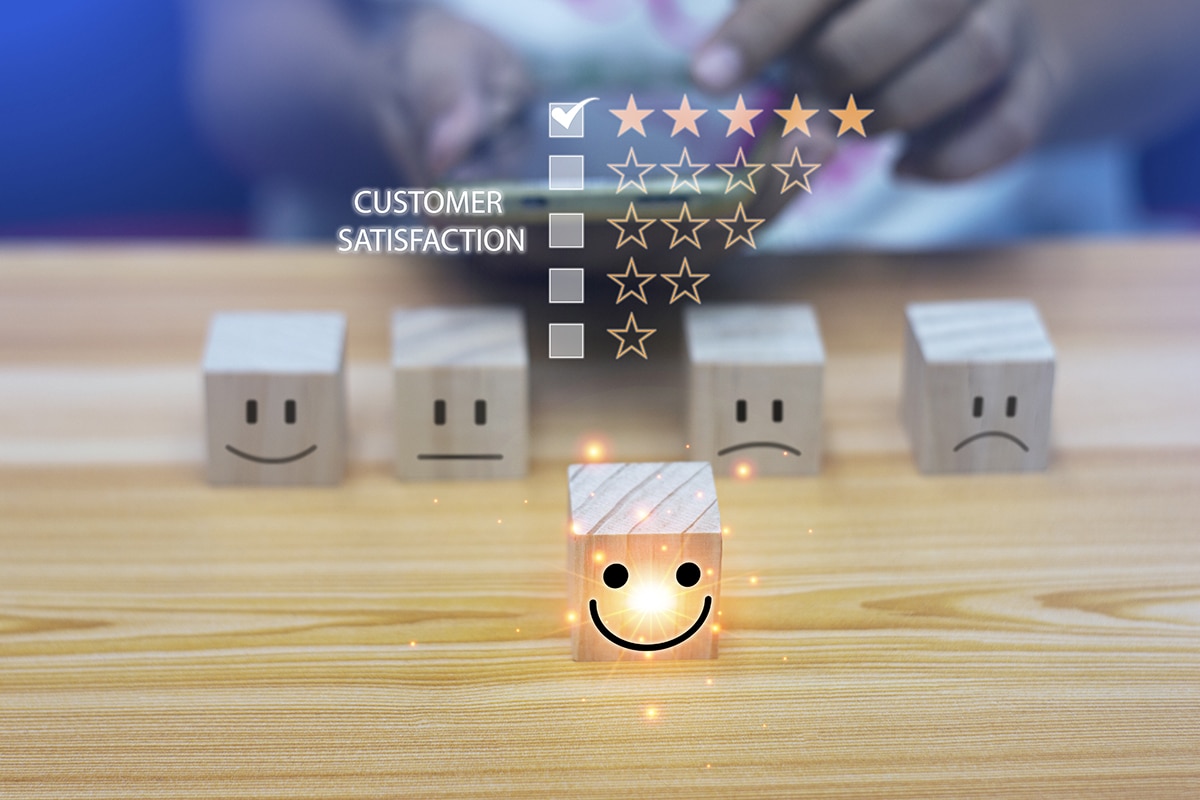It is no secret that any business that wants to survive must learn how to satisfy its customers. However, in the ever-changing business sector, satisfying customers alone is no longer enough.
Clients who experience poor service in your business will spread the word to others. Over time, this can negatively affect your sales and your ability to retain customers.
This means companies must learn to create unique customer experiences that will ensure free positive word-of-mouth referrals and return purchases.
Knowing this, we’ll walk you through 17 of the best customer experience practices you can implement in your business today.
Now, let’s begin.
Collect feedback with JustFeedback
JustFeedback helps your business increase profits and reduce risk by improving your customer experience
1. Understand your customers
The more you understand your customers, the better you can be aware of their needs and improve their overall experience. Understanding your customers will let you know what they need and prefer.
With this information, you can then alter your products and services to make the customer journeys straightforward.
So, how do you understand your customer needs? The first and the easiest option is to listen. Customers who purchase your product or service will always have something to say. This could be good or bad, but it doesn’t matter.
Make sure you listen to properly, so you understand how to make customers happy.
Next, use surveys and interviews. These tools can help you gather customer information and create a better experience.
Make sure they have questions that will give you insights into customers. Remember to make your surveys personal by calling customers by name. This way, they will be happier to partake in them.
Another option is to work with your sales and marketing team. These parts of your business engage with your customers daily. This means they have information that you can use to improve customer experience.
2. Map the entire customer journey
The customer journey involves all the interactions a consumer has with your business. To ensure a good customer experience, you must put yourself in the customers’ shoes to understand how they become buying customers.
This way, you’ll discover all the actions and pain points that affect the buying decision—and improve them.
To make this happen, determine the areas in the customer journey where many clients fail to complete a purchase.
Customers expect a smooth process when buying a product or service. Ensure that your customer experience management team makes this possible by removing any obstacles to ensure a more seamless purchase process.
3. Train your customer success team
No customer wants to do business with a company that provides frustrating customer service. Getting everything right with your business when you have terrible customer service can still negatively affect customer experience.
Well-trained support staff can be all your business needs to ensure customer satisfaction. That’s how essential it is to get it right.
To achieve this, provide proper training for all your team members.
This should feature the basics of your products and services and how your company expects to treat customers. Teach your staff to always be customer-focused and always see things from the customer’s perspective before offering solutions.
Also, the team should be granted more power to deal with problems instead of always needing approval from management. This will ensure a quick and straightforward resolution for most issues, which is what customers love.
It will also result in better customer relationships and improved customer experience.

4. Listen to your customer service staff
As mentioned, your team constantly interacts with customers, so they understand their pain points perfectly. Listening to these people who are always on the front lines dealing with customers first-hand can be a great way to improve customer experience.
Make sure you take feedback from your team seriously and adjust as needed.
Aside from meeting customer expectations and improving your business, it helps employees feel appreciated. This is also to your benefit since employees tend to leave jobs where they don’t feel valued or recognized.
5. Frequently apply customer feedback
Another great customer experience strategy is applying customer feedback.
This is a great customer service strategy many top businesses understand and continue to implement. Customers love to be heard, valued, and recognized. So, if they make the effort to provide you with feedback when you ask, it is only wise to work on them.
So, how do you get honest feedback from customers? Here’s some helpful channels:
a. Surveys
You can politely ask customers to fill out surveys after they complete a purchase from your business. This can provide valuable insights into what areas clients want you to ensure a better customer experience.
When creating surveys, use open-ended questions to keep conversations going. Asking straightforward questions means you get yes/no answers – which might not provide you with the information you need.
b. Social media
When I am satisfied about a product or have problems, I leave feedback on the social media page of the business. This is something many customers do too. Therefore, it is to monitor all your pages and respond politely to customers who leave feedback.
Then, work on the areas you can and let the customers know they’ve been heard, and the problem has been resolved.
Responding to feedback on your social media pages can also be a great way to draw in paying customers. Prospective customers who see how you interact with others will be more willing to do business with you, knowing you listen.
c. Live chat
The ability to get help any time of the day is a feature I and many other customers love. This shows that the business won’t vanish after a purchase.
You can add a 24/7 live chat feature to your website so customers can get round-the-clock help and leave feedback. Customers can provide feedback via live chat on ways you can improve the customer experience.
Remember that getting feedback is only half the battle. If you are serious about improving customer experience, you’ll need to properly use the feedback you get to improve your products and services.
If you are having problems handling these yourself, why not use AI?
The next section will show you how.
6. Leverage the power of AI models
Artificial Intelligence is becoming an integral aspect of most companies, and you can also use this tool to improve customer experience. For instance, Chatbots can help customers with less complex issues that don’t need human staff.
Chatbots can help answer FAQs or show customers where to find helpful information in the help center. They can also create a ticket for complex problems so a human support staff member can handle them.
Chatbots remove wait times and allow customers to get help in real-time, thus enhancing the customer experience. They also help the support team by reducing their workload, allowing them to focus on more critical issues.
While it is understandable to have doubts about AI, you can’t ignore its benefits. If you’re serious about providing excellent customer experience CX, then it is worth looking into.
7. Personalize customer interactions
Personalization helps to ensure that every interaction a customer has with your business aligns with their experiences. It helps customers build trust in your business and ensures they feel valued and understood.
Developing products and services that meet customers’ unique needs can help boost engagement, conversion, and ultimately, customer experience.
So, how do you personalize customer interactions? We’ll cover a few options in the section below.
a. Personalize communication
Analyze your customer behavior and preferences and use the results to send personalized suggestions. For instance, a customer frequently visits your Laptop sales page and has a wishlist with similar items.
You can create a personalized message showing discounted Laptops and accessories picked for them. Remember that AI can be a great tool to create this based on how a customer interacts with your site.
b. Personalize onboarding
When signing up on some websites, you must first answer specific questions. The platform then uses the answers to create a unique experience.
You can implement this customer experience strategy on your company website to create an onboarding process that aligns with your customers’ preferences.

8. Humanize customer interaction
Interacting with the customer support team of some businesses can often seem robotic. For example, customers can receive a bulk robotic email following a template when they reach out to the team.
While this works, it does not allow customers to connect with your business. Instead, you can create positive interactions by making them feel human using the following tips:
- Teach your support staff to address customers by their first names. You can also attach pictures of your team members to email signatures to make it easier to put faces to the names. This way, customers won’t feel they are interacting with a robot.
- Encourage your team members to take more time helping customers instead of rushing through it and jumping to the next.
- Show your customers that you empathize with them. This means putting yourself in their shoes and genuinely understanding their frustration with a poor experience.
- Teach your staff to respond in a manner that aligns with the customer’s lifestyle and personality.
- Ask customers open-ended questions to keep the conversation going.
- Follow up and see if the problem persists. This will make your customers feel welcome and more likely to buy from you.
9. Set realistic expectations
Setting unrealistic expectations can quickly damage trust with customers, leading to a negative customer experience. Your company must set realistic expectations regarding your services, products, and support to avoid this.
A good example is how fast you can render a service. Provide the customer with a clear and realistic time frame so the client knows how to manage expectations. Don’t make false promises and fail to meet up.
Delays are understandably inevitable in some cases, so update the customer if there will be delays. In addition, here are some helpful strategies to help you set realistic expectations with clients:
- Let your customers know when they’ll be able to reach your support team.
- Use straightforward language that is easy to understand to communicate with customers. Do this when giving information relating to delivery times, service details or completion. Complex grammar is pointless if a customer does not understand what you are trying to say.
- Increase your delivery timeline so you have enough time to deal with unplanned problems. For instance, if you always complete a task within three days, inform the client that it takes five days. This way, if everything goes as planned, you look good, and if it doesn’t, you have enough time to meet up.
- Give constant updates to clients so they are in the loop about their services or orders. Customers love it when you carry them along. They’ll be at ease knowing you are working on their order instead of leaving them wondering.
10. Leverage social media
By now, you probably know that social media is important for any business.
If you use social media correctly, you can interact with customers in a manner that will keep them satisfied. So, how do you use social media to boost customer experience? Here are some valuable strategies.
First, you will want to respond fast. Many companies fail to respond to customer comments, mentions, and messages. While established companies can get away with doing this, the same may not be the case for a growing company.
Ensure you quickly respond to positive and negative feedback and comments on your page. This shows you listen to customers and are serious about improving their experience with your company.
Next, establish an online community. Creating forums and groups that focus on speaking about your services and products on social media can go a long way. This will provide a platform for customers to interact with one another and solve issues.
It is also a great way to encourage prospective customers to interact with your brand and convert into paying clients.
11. Create a user-friendly site
Your website is where clients get their first impression of your company online. Therefore, you’ll want to ensure it is user-friendly and well-designed.
Navigation should be seamless, and the site should be accessible by your target audience from any device.
An easy-to-use website that is visually appealing will encourage clients to spend more time on it. It can also help improve the customer’s journey and lead to conversion.

12. Make refunds easy
Regardless of how careful you are, there are instances where a client may get a damaged product. You’d probably have experienced this if you enjoy shopping online.
When this happens, refunding the product and getting a refund is usually the easiest step for a positive experience.
An easy refund and return process is a great way to develop customer trust. With this, clients will be more likely to buy from you again, knowing that they can easily refund products if there are issues.
To make the refund process easy and keep customers coming back, you must have clearly defined conditions for your refund policies.
They should feature easy-to-understand texts without hidden clauses. This way, clients will have a complete idea about what they can and can’t refund.
Next, look into the return window. Make sure it is realistic to ensure clients have enough time to determine if they want the product or not. 2 weeks is great for smaller items, while larger items can have a 30-day return window.
Lastly, ensure the return process is easy. There shouldn’t be too much documentation that causes delays. If you can, provide a pickup service so clients don’t have to go out of their way to return an item.
13. Flexible business hours
The typical working hours for most businesses are 9 – 5, which is reasonable. However, this leaves clients with queries hanging until the staff resumes the next day.
Instead, you may want to extend your availability and offer services beyond the regular business hours. This may help your company resolve issues faster and lead to a happier customer base.
To do this, consider requesting your staff work on shifts and take overtime for extra pay. Better still, hire remote team members who can help address issues from the comfort of their homes.
14. Understand why clients leave
Getting customers is one thing, but retaining them is another difficult hurdle to overcome. To constantly ensure you retain customers, you need to understand why they leave so you can close that gap.
If unhappy customers let you know they’ll be doing business elsewhere, try to offer solutions that might encourage them to stay.
For instance, if clients frequently tell you they found better services elsewhere, you could try to see what the competition is doing and match the service. This may help you improve retention or give you insights into how to prevent customers from leaving.
If clients leave despite your efforts, you can use the information you get to improve your company’s processes. Also, try holding exit interviews with clients if your sector permits it. Here, you can speak with them and discuss their reasons for leaving your business.
Customer surveys can also be a great alternative to interviews to determine pain areas so you can quickly address them.
15. Measure customer experience levels
You can monitor various metrics to set goals and create a unique customer experience. Here are some of the metrics to keep an eye on if you want to improve customer experience:
a. Customer satisfaction score
This will help your customer experience management quantify your success in satisfying customers. You can use surveys with questions that ask clients to rate their overall experience with your company.
The data you get from these surveys can give you insights into whether your customers are happy or not.
b. Response time
This applies to the customer service department. It shows how long it takes to respond to the complaints of customers.
A slow response time is a sign of a negative customer experience for an organization. You’ll want to aim for a positive score to improve customer experience.
c. Resolution time
The resolution time metric measures how long it takes for a member of the customer support team to resolve a customer’s problem. A quick response time is a sign of a positive customer experience, while a slow response proves otherwise.
16. Make it easy to buy
A tedious checkout process can be very frustrating for new customers and may cause them to abandon their carts without making payments. Simplifying the checkout process can help address this and boost customer experience and conversion rate.
No customer wants a tedious shopping experience, and an easy checkout process ensures this. The following are a few tips to improve your company’s checkout process:
a. Make the checkout process seamless
Limit the number of forms and pages during the checkout process. This serves no purpose but to frustrate potential customers into abandoning their carts and failing to complete purchases.
Instead, stick with one or two pages for easy checkout. Try to avoid repetition when filing forms and only use those that ask for relevant information.
b. Great range of payment methods
Don’t limit payments to only one option, or customers who use other payment methods may leave. Instead, multiple payment methods should be provided, with the option of paying in installments or entering a payment plan.
This will make it easier for customers who earn a salary to budget and purchase items – which means more sales for you and happy customers.
17. Reward customer loyalty
Everyone loves freebies, and rewarding customer loyalty is an excellent way to boost customer experience. You can do this by offering discounts, exclusive access to new products, and recognition to loyal clients via newsletters or similar outlets.
Loyalty programs will also encourage clients to create an account and log in when they want to purchase your service or product. This will provide you with useful data that you can use to create data and offer users services that are tailored to their needs.
Conclusion
Offering great customer experience requires more than one strategy. Successful businesses know that they must understand customers, listen to their teams, and train the customer service team.
They also know the importance of combining the other strategies we have covered.
You, too, can tap into this by using these customer service practices listed in this guide. If you do it right, you can improve customer satisfaction, loyalty, and retention.
